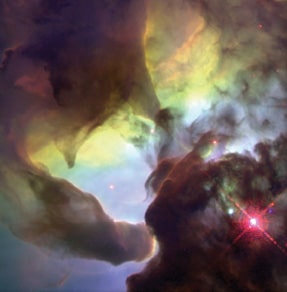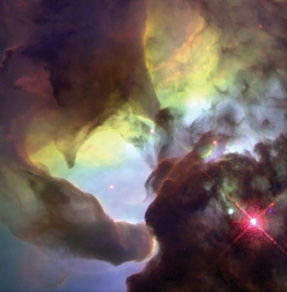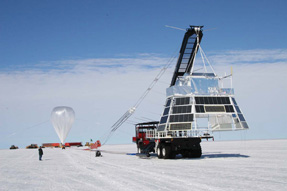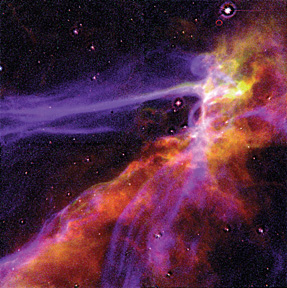Life
What's The Matter With Antimatter?

Can you imagine antiworlds and antipeople out there?
| Modern science has shown that matter and the material world is just one side of a coin. If our world is made of normal matter, it is equally logical to think of a world composed of antimatter.
Matter and energy are manifestation of the same underlying entity. In particle physics, every particle has a corresponding antiparticle. Particles — like electrons, protons and neutrons — make up ordinary matter, while their antiparticles — such as positrons (anti electrons), antiprotons and antineutrons — make up antimatter. Sequential logic allows us to imagine the existence of anti-entities, such as antiplanets or antihumans. However, the existence of antimatter is ruled out at least in this universe, because matter won over antimatter in the battle of existence that occurred 13.7 billion years ago in the Big Bang. The after-effect of that battle is the Cosmic Microwave Background (CBM) radiation, which is the first energy (light) formed in the universe as a result of the mutual annihilation of matter and antimatter.
The physicist Stephen W Hawking noted in A Brief History of Time: “We now know that every particle has an antiparticle, with which it can annihilate. There could be whole antiworlds and antipeople made out of antiparticles. However, if you meet your antiself, don’t shake hands! You would both vanish in a great flash of light.” This physical reality has expressions in mythology, religion and folklore as the epic battle between good and evil. In Hindu literature, the Devas govern the regions of heaven and are opposed by the demonic Asuras. In the cosmic struggle between the forces of order and chaos, Devas support humans who inhabit the earth. The conflict between Devas and Asuras is described in the myth of the churning of the “ocean of milk” (Palazhi) for treasures, including Amritha, which provides strength (energy) and immortality. This battle between matter and antimatter is an ongoing event, although science has not yet confirmed the subsistence of such conflicts beyond the early universe. Standard cosmological theory suggests that the universe began with equal amounts of matter and antimatter, like the twins of Big Bang. However, in the early universe this super symmetry was broken for unknown reasons, leading to the dominance of matter in this universe. It is one of the unsolved mysteries in science, known as the Baryon asymmetry problem in physics. Assuming that there were equal amounts of matter and antimatter in the early universe, their mutual destruction would have caused the complete absence of any matter. The whole universe would have been filled with energy (light) created in that process.
One possible solution to this puzzle is that there are two universes, one with matter dominance (our universe), and the other with antimatter dominance, without any interaction between them. This explanation remains highly implausible in the scientific research of the last decades and none of the existing theories are capable of providing an explanation of the matter supremacy in our universe. The Large Hadron Collider at European Organization for Nuclear Research (CERN), could possibly shed some light into the broken symmetry in the early universe. CERN is striving to create antimatter in its Antiproton Decelerator, popularly known as antimatter factory, which plays a crucial role in the production and analysis of antiparticles and thus antimatter. The Rig Veda, the ancient Hindu text, dwells on fundamental particles and forces of nature as it describes the creation of the universe from the remains of a gigantic primeval Cosmic Man. Creation happened gradually; the universe in its primitive form primarily spread homogeneously throughout the universe. The complete equilibrium and homogeneity, when broken, arose an inhomogeneous state of the primordial fluid. “Which of these two came earlier, which came later?
The power of matter-energy transition was vividly on display in the detonation of the nuclear bomb in the New Mexico desert in 1945. On seeing the fireball and mushroom cloud, J. Robert Oppenheimer, the director of the Manhattan project, who had a deep interest in religion, Hinduism in particular, recalled a passage from the Bhagavad-Gita: “I am become death the destroyer of worlds. If the radiance of a thousand suns were to burst at once into the sky, that would be like the splendor of the mighty one.” The matter-antimatter annihilation produces pure energy even more efficiently than nuclear fission or fusion. According to Einstein’s equation, E=mc2, the mutual annihilation of 1 kg each of matter and antimatter could produce energy equivalent to that of the most powerful nuclear bomb ever tested, which in turn uses hundreds of kilograms of nuclear material. This remarkable energy formation from nearly negligible amounts of matter is appealing to scientists and fiction writers alike, such in the 2009 movie Angels & Demons based on Dan Brown’s novel by the same name. “The fact that Angels & Demons is a best-selling novel and now a Hollywood movie gives us the opportunity to show how exciting the reality of antimatter research is,” says CERN Research Director Sergio Bertolucci. Even though the existence of antimatter is well established, the biggest particle accelerators in the world have been able to create only a handful of anti particles. CERN and the U.S. government’s Fermi National Accelerator Laboratory (Fermilab), located in Batavia near Chicago, Illinois, have produced anti particles, including antihydrogen atoms, but not in any measurable quantities. The first antihydrogen atom was created at CERN in 1995. As of now, antimatter particles are considered to be the most expensive particles to produce, at an estimated cost of $62.5 trillion a gram. Given the cost of production and lack of storing techniques, these particles remain illusive, at least in the near future. But scientists are hopeful that in the coming years they will find ways to generate antimatter in larger quantities and develop advanced techniques to store this mysterious matter.
Elusive as it remains, antimatter animates immense excitement in the scientific community. NASA is actively pursuing it as a possible source of future rocket fuel. Scientists envision an unlimited supply of energy from a small amount of material to propel rockets to planets and stars. The brain scanning procedure known as PET (Positron Emission Tomography) exploits the electron-positron annihilation to reveal the workings of the brain. The positron created by the radioactive decay process is used to annihilate an electron in the atom of the brain, rendering an image of the brain on the screen. Researchers are optimistic about the use of antiproton in tumor irradiation in the future. Hydrogen atoms, being the most simple in structure (one proton and one electron), its antimatter antihydrogen (one anti proton and a positron) is the easiest antimatter to synthesize. The ATHENA (AnTiHydrogEN Apparatus) at CERN was an international collaboration to produce antihydrogen atoms at low temperature for experimental purposes. ATHENA has produced tens of thousands of anti hydrogen atoms. However, it was practically impossible to capture the antihydrogen atoms because of the high temperatures associated with them. The high energy antihydrogen atoms hit the wall of the experimental apparatus and annihilated with atoms of normal matter. The analysis of antihydrogen atoms would reveal the difference between matter and antimatter beyond theoretical assumptions and possibly validate the theories of the absence of antimatter in our universe. Though the ATHENA experiment came to an end in 2004, another ATRAP (Anti Hydrogen Trap) collaboration is still in operation. Its goal is to create antihydrogen at a lower temperature that can be trapped long enough to compare with ordinary hydrogen.
If and when they succeed, it will be a tribute to the invocation by Paul Dirac, a pioneering quantum physicists, who predicted the possibility of anti particles for the first time in 1928: “Pick a flower on Earth and you move the farthest star.” |





